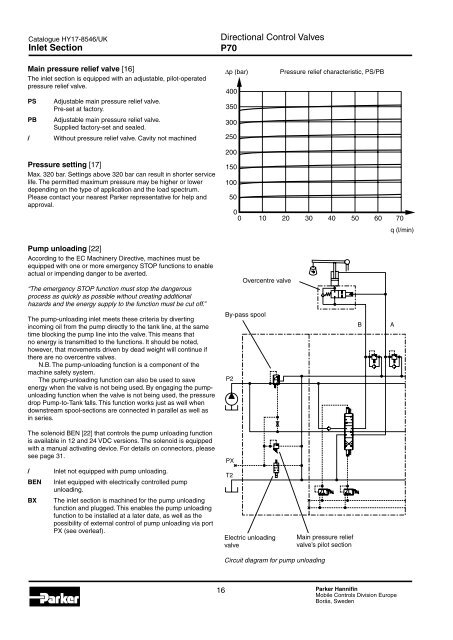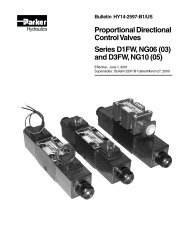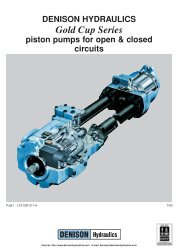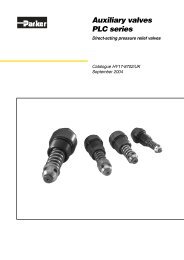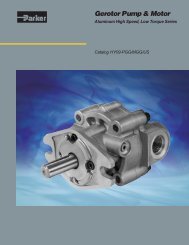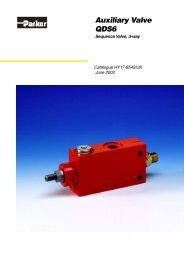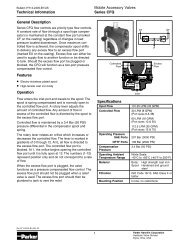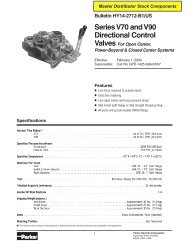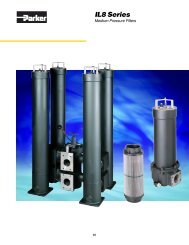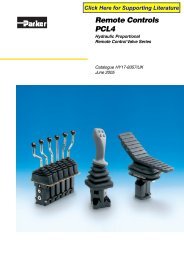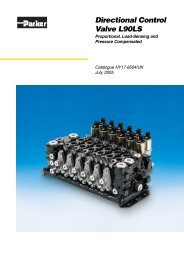Directional Control Valve P70 - Oleosistemas
Directional Control Valve P70 - Oleosistemas
Directional Control Valve P70 - Oleosistemas
Create successful ePaper yourself
Turn your PDF publications into a flip-book with our unique Google optimized e-Paper software.
Catalogue HY17-8546/UK<br />
Inlet Section<br />
<strong>Directional</strong> <strong>Control</strong> <strong>Valve</strong>s<br />
<strong>P70</strong><br />
Main pressure relief valve [16]<br />
The inlet section is equipped with an adjustable, pilot-operated<br />
pressure relief valve.<br />
PS<br />
PB<br />
Adjustable main pressure relief valve.<br />
Pre-set at factory.<br />
Adjustable main pressure relief valve.<br />
Supplied factory-set and sealed.<br />
/ Without pressure relief valve. Cavity not machined<br />
Pressure setting [17]<br />
Max. 320 bar. Settings above 320 bar can result in shorter service<br />
life. The permitted maximum pressure may be higher or lower<br />
depending on the type of application and the load spectrum.<br />
Please contact your nearest Parker representative for help and<br />
approval.<br />
∆p (bar)<br />
400<br />
350<br />
300<br />
250<br />
200<br />
150<br />
100<br />
50<br />
Pressure relief characteristic, PS/PB<br />
0<br />
0 10 20 30 40 50 60 70<br />
q (l/min)<br />
Pump unloading [22]<br />
According to the EC Machinery Directive, machines must be<br />
equipped with one or more emergency STOP functions to enable<br />
actual or impending danger to be averted.<br />
“The emergency STOP function must stop the dangerous<br />
process as quickly as possible without creating additional<br />
hazards and the energy supply to the function must be cut off.”<br />
Overcentre valve<br />
The pump-unloading inlet meets these criteria by diverting<br />
incoming oil from the pump directly to the tank line, at the same<br />
time blocking the pump line into the valve. This means that<br />
no energy is transmitted to the functions. It should be noted,<br />
however, that movements driven by dead weight will continue if<br />
there are no overcentre valves.<br />
N.B. The pump-unloading function is a component of the<br />
machine safety system.<br />
The pump-unloading function can also be used to save<br />
energy when the valve is not being used. By engaging the pumpunloading<br />
function when the valve is not being used, the pressure<br />
drop Pump-to-Tank falls. This function works just as well when<br />
downstream spool-sections are connected in parallel as well as<br />
in series.<br />
By-pass spool<br />
P2<br />
B<br />
A<br />
The solenoid BEN [22] that controls the pump unloading function<br />
is available in 12 and 24 VDC versions. The solenoid is equipped<br />
with a manual activating device. For details on connectors, please<br />
see page 31.<br />
/ Inlet not equipped with pump unloading.<br />
BEN Inlet equipped with electrically controlled pump<br />
unloading.<br />
BX The inlet section is machined for the pump unloading<br />
function and plugged. This enables the pump unloading<br />
function to be installed at a later date, as well as the<br />
possibility of external control of pump unloading via port<br />
PX (see overleaf).<br />
PX<br />
T2<br />
Electric unloading<br />
valve<br />
Main pressure relief<br />
valve’s pilot section<br />
Circuit diagram for pump unloading<br />
16 Parker Hannifin<br />
Mobile <strong>Control</strong>s Division Europe<br />
Borås, Sweden


